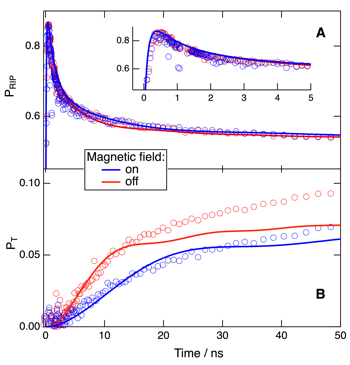-
Magnetic field effect on ion pair dynamics upon bimolecular photoinduced electron transfer in solution
S.V. Feskov, M.V. Rogozina, A.I. Ivanov, A. Aster, M. Koch and E. Vauthey
Journal of Chemical Physics, 150 (2) (2019), p24501


DOI:10.1063/1.5064802 | unige:114615 | Abstract | Article HTML | Article PDF | Supporting Info

The dynamics of the ion pairs produced upon fluorescence quenching of the electron donor 9,10-dimethylanthracene (DMeA) by phthalonitrile have been investigated in acetonitrile and tetrahydrofuran using transient absorption spectroscopy. Charge recombination to both the neutral ground state and the triplet excited state of DMeA is observed in both solvents. The relative efficiency of the triplet recombination pathway decreases substantially in the presence of an external magnetic field. These results were analyzed theoretically within the differential encounter theory, with the spin conversion of the geminate ion pairs described as a coherent process driven by the hyperfine interaction. The early temporal evolution of ion pair and triplet state populations with and without magnetic field could be well reproduced in acetonitrile, but not in tetrahydrofuran where fluorescence quenching involves the formation of an exciplex. A description of the spin conversion in terms of rates, i.e., incoherent spin transitions, leads to an overestimation of the magnetic field effect.